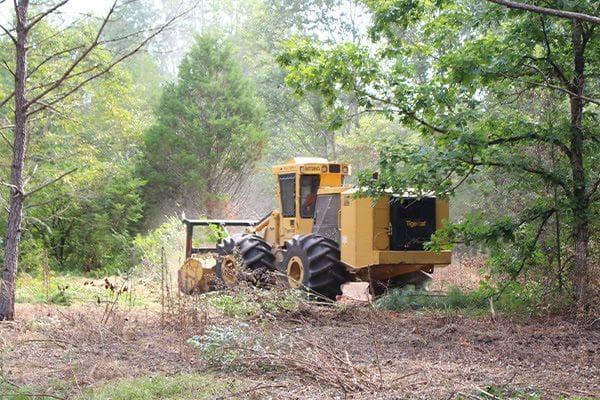Partnership Enhances Wild Turkey Brood Habitat

EDGEFIELD, S.C. — The Mississippi NWTF State Chapter continues a five-year wild turkey habitat partnership with the Mississippi Department of Wildlife, Fisheries and Parks on the Canal and Divide Section WMAs in the northeastern corner of the state.
The approximately 15,300-acre Divide Section WMA, located in Tishomingo County on both sides of the Tennessee-Tombigbee Waterway, is leased through the Army Corps of Engineers to the MDWFP for wildlife management and public hunting access.
Wild turkeys were completely absent in the area until they were re-stocked in the mid-1980s, around the time the Tennessee-Tombigbee Waterway was completed. Since then, the Army Corps of Engineers and MDWFP have managed the property to increase wild turkey populations, other game and nongame species and overall ecological health. And thanks to recent efforts, wild turkey populations continue to expand.
“Since 2018, NWTF Mississippi has contributed funds to increase the amount of early successional habitat on the WMA,” said Kacie Bauman, NWTF district biologist for Mississippi, Louisiana and Arkansas. “Turkeys are now utilizing the managed areas where once it was overrun with invasive plant species. This is why the state chapter invests in this project year after year.”
Early successional habitats are areas with vigorously growing grasses, forbs, shrubs and trees that provide excellent food and cover for wild turkeys. Examples of early successional habitat include weedy areas, grasslands, old fields or pastures, shrub thickets and young forests.
Providing funds from its Super Fund, the Mississippi NWTF State Chapter recently helped with the costs of mulching 40 acres of invasive and undesirable vegetation and turning it into the early successional habitat that wild turkeys need. Since the partnership began in 2018, about 200 acres of early successional habitat have been created on Divide Section WMA. This increase will provide critical forage and cover during nesting and brood-rearing periods for wild turkeys. Wildlife managers will manage the areas into perpetuity to remain optimal for wild turkeys.
“Autumn olive and Callery pear are two highly invasive plant species that are difficult to manage and had taken over most of the site,” said Nathan Blount, MDWFP northeast WMA biologist. “Mulched areas will be maintained through the use of prescribed fire, herbicide and strip disking.”
In addition, the overall project has enhanced 8.5 miles of the levee system of the Tennessee-Tombigbee Waterway within nearby Canal Section WMA by removing undesirable woody brush to promote better quality brood habitat. Brush removal increases water quantity and quality, opens wildlife corridors, increases native vegetation growth, provides recreational access and increases wild turkeys’ ability to use the area. Most of Canal Section WMA is comprised of bottomland hardwoods, so enhancement of openings along existing levees constitutes some of the area’s best opportunities to increase brooding habitat.
In both the case of early successional habitat and waterway enhancements, work has been conducted by using forestry mulching on the front end to reclaim brush-bound areas quickly, then followed up with combinations of herbicide and prescribed fire, reverting and maintaining these areas in high-quality brood habitat.
“Based on my figures across these areas, the Mississippi NWTF Super Fund has directly contributed $44,552 in these two areas since 2018, which has been matched by $81,255 direct or in-kind from MDWFP and $70,000 from the Corps of Engineers,” said Adam Butler, MDWFP wild turkey program coordinator and NWTF wild turkey technical committee member. “So, through multi-year funding, nearly $195,807 total worth of management has taken place to help turkeys along the Tennessee-Tombigbee Waterway in the past five years. The really cool thing is that the Corps has like the results so much they’re now working with our regional biologist Justin Hughes to develop an even bigger proposal to treat the entire length of the levee system within Canal Section WMA.”
The work on the two WMAs bolsters the NWTF’s new Habitat for the Hatch initiative. Habitat for the Hatch is laser-focused on creating essential nesting habitat near quality brood range. This new initiative seeks to create 1 million acres that fit these criteria in the next 10 years. The recently enhanced acres on the Canal and Divide Section WMAs will contribute to Habitat for the Hatch’s 1-million-acre goal.
About the National Wild Turkey Federation
Since 1973, the National Wild Turkey Federation has invested over half a billion dollars into wildlife conservation and has conserved or enhanced over 22 million acres of critical wildlife habitat. The organization continues to drive wildlife conservation, forest resiliency and robust recreational opportunities throughout the U.S. by working across boundaries on a landscape scale.
2023 is the NWTF’s 50th anniversary and an opportunity to propel the organization’s mission into the future while honoring its rich history. For its 50th anniversary, the NWTF has set six ambitious goals: positively impact 1 million acres of wildlife habitat; raise $500,000 for wild turkey research; increase membership to 250,000 members; dedicate $1 million to education and outreach programs; raise $5 million to invest in technology and NWTF’s people; and raise $5 million to build toward a $50 million endowment for the future. Learn how you can help us reach these lofty goals.
The post Partnership Enhances Wild Turkey Brood Habitat appeared first on HuntingLife.com.
